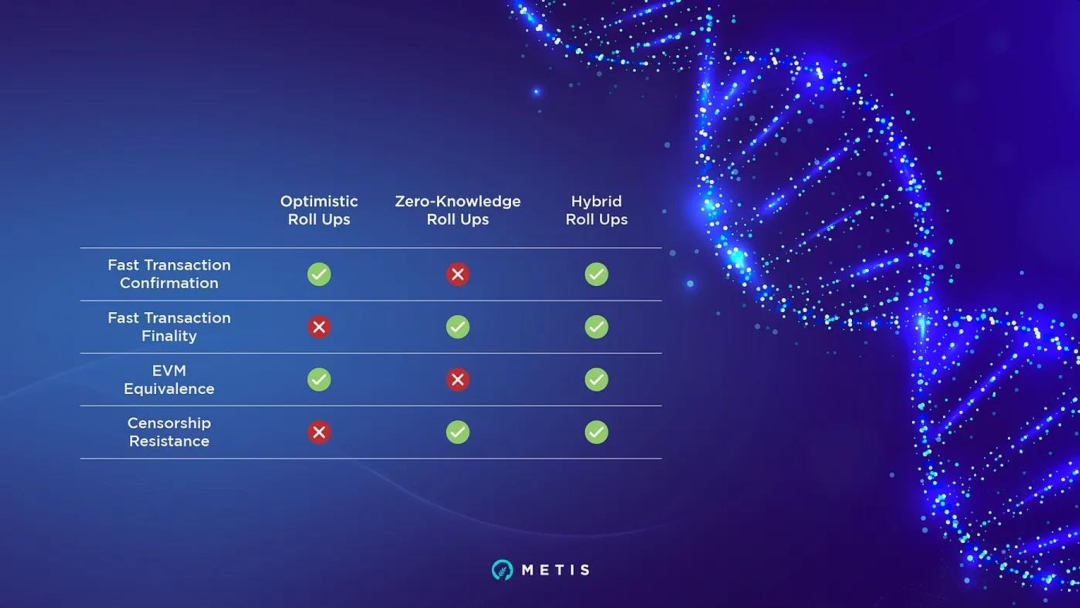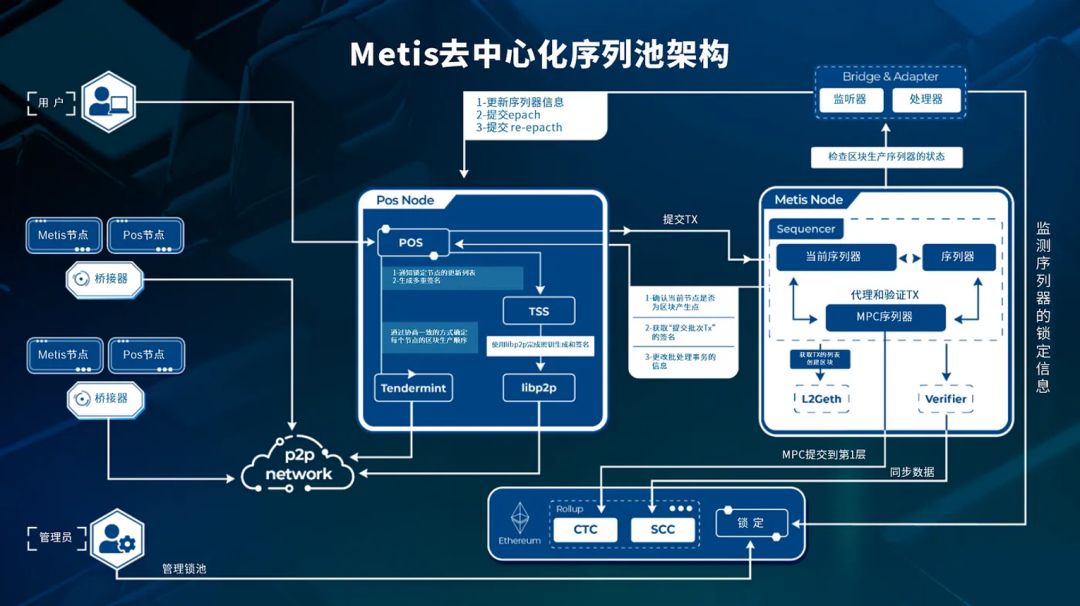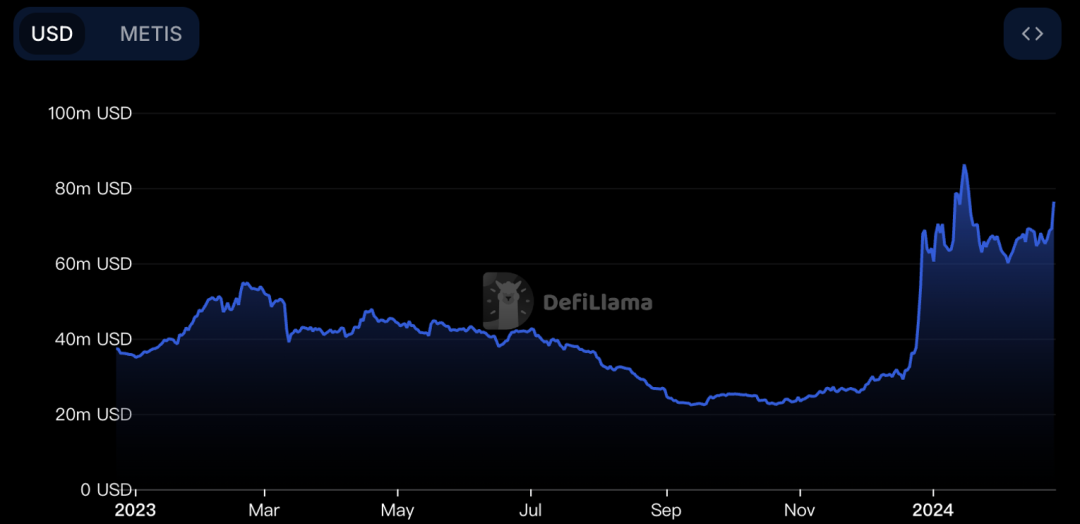Original author: Biteye core contributor Lucky
Original editor: Biteye core contributor Crush
Metis, which has surged 5 times in 3 months, has undoubtedly firmly captured the publics attention on the eve of the Cancun upgrade. So, what is driving the development of Metis behind this?
This article brings you a comprehensive analysis of Metis’ progress in terms of technology, ecological development flywheel, decentralized sorter, etc., and is committed to giving readers a clearer understanding of Metis’ ecology.
1. Introduction to Hybrid Rollups
MetisDAO is a Layer 2 scaling solution compatible with the Ethereum Virtual Machine (EVM). Like other Layer 2 solutions, it reduces the pressure on the Ethereum blockchain by packaging L2 transactions and sending them to the L1 network.
But unlike other L2s, Metis uses innovative Hybrid Rollups technology, combining two mainstream blockchain expansion solutions: Optimistic Rollup (OP Rollup) and Zero-Knowledge Proofs Rollup (ZKPs Rollup).
OP Rollup handles potentially dishonest transactions through its fraud proof mechanism, while ZKPs provide a more secure verification method, ensuring that only valid transactions are confirmed. Therefore, Metis Hybrid Rollup effectively reduces the risk of fraud and erroneous transactions.
Metiss Hybrid Rollup makes Metis both efficient and secure when processing a large number of transactions, and the scalability of the entire system will not be limited. Any DAPP compatible with EVM can be seamlessly connected to Metis. In this way, Metis not only provides users with an efficient and secure trading environment, but also provides a convenient access platform for DAPP developers.

In the implementation of Hybrid Rollup, Metis incubated the zkMIPS project to help the implementation of Hybrid Rollup: ZKM, ZKM implements zero-knowledge proof of all virtual machines (VMs) and applications from the CPU level (ZKP) security, and supports a variety of blockchain smart contract engines, allowing developers to simply apply ZKP for development.
ZKM can verify all blockchain and non-blockchain transactions, and can also reduce gas fees and shorten withdrawal waiting times. The introduction of ZKM is one of Metis technical advantages over other L2s.
In addition to its Hybrid Rollup technology, the most eye-catching development direction of Metis in this round is its upcoming decentralized sorter.
2. Decentralized sorter
The sequencer is the role in L2 responsible for sorting, sorting, packaging and submitting transactions to the L1 network. Currently, most L2 projects (including Optimism, Arbitrum) rely on a single sequencer to complete the above work, which leads to the possibility of 3 risks:
1) Single point of failure. If the sequencer fails due to an attack or technical failure, the entire network will be shut down;
2) Scalability issues. A single sequencer may struggle to cope with increasing transaction volumes;
3) Low resistance to censorship.
In addition to the above problems, the centralized sorter also allows the community and on-chain users to become passive participants in the network and cannot share the sorter revenue with the public chain.
In order to solve the above problems, MetisDAO plans to launch a decentralized sequencer pool (Sequencer Pool) to solve the risks related to centralized sequencers, increase the scalability of the network, and establish a sustainable and community-centered unique Layer 2 .
Advantages brought by Metis implementation of decentralized sorter:
1) In a decentralized sorter pool, multiple sorters work together. Any sorter that enters through staking has the right to see the contents of the transaction pool and process transactions, making it impossible for a single sorter to maliciously manipulate; this not only Improves the speed of transaction processing and increases the fault tolerance of the network (even if one sequencer fails, the network can still operate normally);
2) Users can become new sequencer nodes by staking the native token METIS, while allowing network participants to supervise the sequencer nodes, improving the transparency and credibility of the entire system;
3) From the perspective of sustainable community development, node staking also helps reduce the supply of METIS in circulation, which may have a positive impact on the long-term value of the token;
4) The launch of the sequencer pool also means that liquidity staking/re-staking will be introduced into the Metis ecosystem. Liquidity staking has become one of the most important components in the Defi field since last year, occupying the largest TVL in Defi Cake, the introduction of liquidity staking into the Metis ecosystem can bring more possibilities and $Metis use cases to its ecosystem.

As shown in the figure above, Metis’ Sequencer transaction process:
1. Start: the user starts trading;
2. Sequencer node: The transaction is forwarded to the sequencer node of the network;
3. Block generation: Sequencer receives transactions and creates blocks when the transactions are valid;
4. Finalization: Multi-party computation (MPC) nodes merge these blocks and forward them to the Ethereum main chain.
In order to encourage community participation, Metis also provides staking rewards for sorter nodes, which means that in addition to Gas income (the main income of current sorting), these nodes can also receive additional METIS rewards.
This design will encourage more members to participate in the staking of the sequencer node. On the one hand, it ensures that power will not be overly concentrated, and at the same time, it also strengthens the concept of decentralization.
Before the decentralized sorter is officially launched, Metis will conduct 3 phases of community testing. Currently, the Metis sorter pool has undergone 2 rounds of community testing. The first round started from 1.3 and lasted for 27 days; the first round of testing lasted nearly 27 days. 20w users participated, resulting in 400w on-chain transactions;
The second round of test participants exceeded 300,000 users, and the network executed more than 1,100,000 on-chain transactions. Friends who missed the first two rounds of testing can pay more attention to the release time of the third round of community testing and participate in the third round of testing in time.
3. Ecological Incentive Flywheel
On December 18 last year, Metis officially launched the MetisEDF (Metis Ecosystem Fund (EDF)) development plan, aiming to allocate 4.6 million METIS to further promote the development and innovation of the Metis system.
Based on the current price of Metis of $106, the ecological fund is nearly 500 million US dollars, which is the largest ecological incentive fund among all L1/L2 in the past two years.
The funds allocation is as follows:
Sequencer mining: 65.4% (three million $METIS, this part of the funds is used to incentivize the mining revenue of the sequencer node and promote community participation)
Ecosystem funding: 34.6% ($1.6 million METIS, this part of the funds is used to support project development, protocol deployment, liquidity provision, user incentives and other measures that contribute to ecological development) )
On February 8, Metis officially announced the launch of the Liquid Stake Blitz plan, which aims to use the MetisEDF ecosystem development fund with a total of 4.6 million METIS to accelerate the growth of the LSD protocol and LSD-focused products on the Metis network.
According to the Liquid Stake Blitz plan, from February 8 to the end of February, the LSD protocol of the Metis ecosystem will be able to initiate proposals within the Metis community governance system and enter the formal voting process in March.
After the voting ends, a limited number of winning protocols can win the right to be paired with decentralized sorter nodes (i.e., whitelist seats), thereby gaining stable node participation qualifications and receiving 20% of the MRR (Mining Mining) in the first year. Reward Rate) mining incentives.
What we need to note is that the development of the LSD protocol in the Metis ecosystem is very helpful in lowering the staking threshold on the network.
Unlike the LSD protocol on Ethereum, which lowers the threshold for POS node staking, the Metis ecosystem’s staking protocol such asENKIWhat is lowered is the threshold for staking the sorter node.
This gives ordinary users more revenue opportunities:
1) At least 20% guaranteed mining income provided by the ecological fund;
2) Airdrop rewards of corresponding LSD future tokens;
3) Increase the demand for METIS so that the METIS ecosystem can achieve positive developmentflywheel effect。
Taking Enki as an example, the protocol has launched a genesis airdrop program called Fantasy in early February, which will airdrop 1 million ENKI (accounting for 10% of the supply) to community users as rewards;
In addition, Enki also announced that the team will not retain any tokens, and other ENKI tokens accounting for 90% of the total supply will be released in various forms over time, which means that Enki users can re-pledge eMETIS to seMETIS. Or continue to obtain ENKI benefits through various protocol interaction activities such as METIS/eMETIS LP pairing.
For large financial entities, they can pledge 20k-100k Metis tokens to become a sorter node.
For individual users, they can pledge Metis to different LSD platforms to obtain corresponding node benefits. At the same time, the pledged certificates can also be circulated and used in the ecosystem.
The pioneer of decentralized sorters, the emergence of the revenue sharing model, and the development of LSD all make $METIS fundamentally different from other L2 tokens.
For other L2 native tokens, they only have governance functions and cannot share income for holders.
Therefore, we can see that when Metis is empowered with income, more people are willing to participate and become nodes, driving more tokens to be pledged, further promoting the shortage of Metis token supply and driving further price growth.
And price growth attracts more participants, making the ecosystem more prosperous. The prosperity of the ecology makes the incentives of the sequencer nodes stronger, and more people participate in staking. The entire development process gradually forms a positive flywheel.
4. Ecological development status and key projects

The current TVL of Metis is $82.82 M. From the above-mentioned changes in Metis TVL since 2023, we can see that since Metis launched the design of the decentralized sorter in 2024, the on-chain TVL has grown significantly, proving that the community And the market is optimistic about this direction.
The current key projects of the Metis ecosystem are as follows:
1. ENKI: The first LSD project on the Metis ecosystem, aiming to simplify and democratize participation in the Metis sequencer node ecosystem. It enables ordinary investors to obtain rewards by staking Metis Sequencer nodes. It is currently in the test network and has not yet been officially launched;
2. Hera Finance: An AI-driven DEX aggregator that helps users find the best trading prices.
4. Ethena: The recently popular stablecoin protocol on Ethereum aims to provide censorship-resistant, scalable cryptocurrency-native solutions to the crypto world through USDe. 2.28 Announced collaboration with Metis ecosystem.
5. Aave: Currently the largest TVL agreement on Metis and the largest lending agreement in the entire chain.
6. Hermes Protocol: A DEX that allows users to trade without slippage.
7. Net Swap: The first DEX in the Metis ecosystem, allowing users to conduct fast and low-fee token transactions on the Metis network.
8. Tethys Finance: The first perpetual trading protocol in the Metis ecosystem, allowing users to use up to 50 timesLeverage tradingMAJOR COINS AND METIS
9、Stargate: An asset cross-chain bridge developed by LayerZero Labs, a cross-chain interoperability protocol standard. Through Stargate, users and Dapps can transfer assets across multiple chains.
10. Artemis Finance: A liquidity staking protocol designed specifically for the Metis decentralized sorter pool. It is also one of the two LSDs officially announced by Metis to cooperate. Users can stake their $METIS tokens on Artemis and obtain liquid tokens $artMETIS, automatically accumulating profits and using $artMETIS to interact on the Metis chain.
11. WAGMI: A comprehensive Defi solution whose liquidity pool can automatically rebalance and dynamically allocate funds to maximize user profits when trading. It received a 200 w Grant from the Metis Ecological Fund and announced its cooperation with DWF.
Metis ecological incentives have just been launched, which also means there are alpha opportunities and are worth keeping an eye on.
5. Summary
As the first Ethereum Rollup to adopt a decentralized sorter, Metis provides users and DAPP developers with an efficient, secure trading environment and convenient transaction environment with its unique Hybrid Rollups technology and the upcoming decentralized sorter. Access the platform.
With the continuous growth of the Metis ecosystem, the advancement of multiple key projects and the official launch of the subsequent decentralized sorter, with the positive incentives of its ecological fund, we have reason to believe that the Metis ecosystem is expected to occupy a place in the L2 competition. , bringing more value and opportunities to users and developers.



